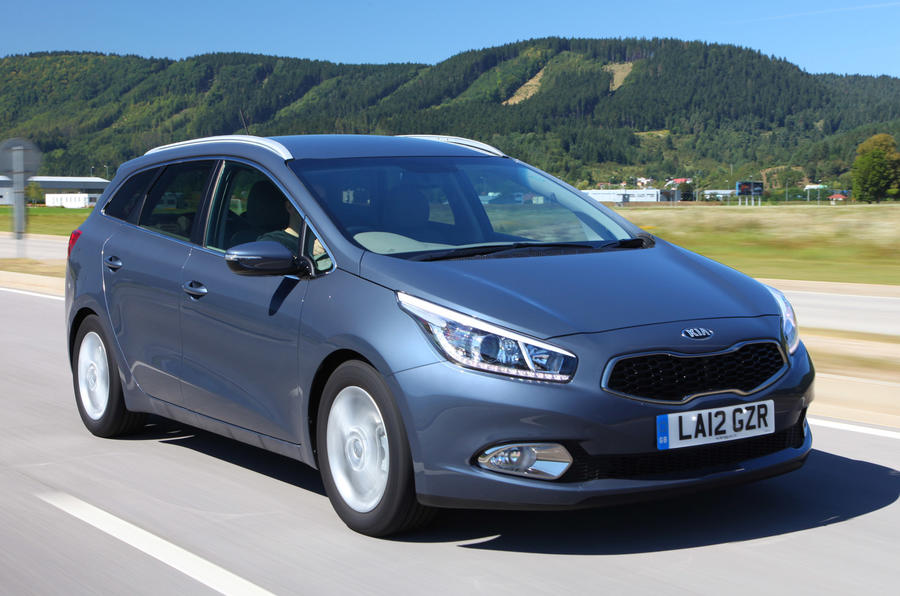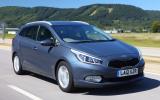What is it?
This is the latest addition to Kia’s UK line-up, the second-generation Cee’d estate, now badged Sportswagon rather than SW. Its appearance is somewhat inevitable given the recent launch of its mechanical twin, the Hyundai i30 Tourer, but Kia UK sees it as an important model for both its fleet and private markets.
The Sportswagon gets a choice of 89bhp 1.4 or 126bhp 1.6-litre diesel engines and four and a half trim levels: 1, 2, 3, 4 and 4 Tech.
There are no options other than metallic paint; instead, all the extras are packaged across the trim grades, which simplifies both choosing your Cee’d estate and paying for it.
The entry-level 1.4 diesel comes in 1 trim only, which nevertheless gets air-con, Bluetooth and six airbags; we drove the likely UK volume seller, a 1.6CRDi 3, which brings the added luxuries of privacy glass, front-seat lumbar support, dual-zone air-con and touchscreen sat-nav.
All models get a six-speed manual gearbox, or there’s a six-speed automatic model available in 2 trim only.
What's it like?
Kia’s slick packaging of trim levels and options extends to its execution of the second-gen Cee’d estate. Never mind the restrained flair of the Euro-flavour styling; this is a smooth, easy steer that exudes a competence that belies the Sportswagon’s place in the market.
It’s also got a cavernous 528-litre boot, which expands to 1642 litres thanks to 60/40 split-fold rear seats – dimensions that beat all of the Cee'd's obvious rivals and are only matched, unsurprisingly, by the i30 Tourer.
So that’s all good then, but the Sportswagon won't win over enthusiasts with any degree of engagement in the process of going round corners.
Neither, however, will it cause any offence. In fact, there are elements at which the chassis excels, with impressively sophisticated bump absorption and isolation. Steering is precise and nicely weighted, too, and the ride and rolling refinement of our UK-spec test cars was a class act, at least on the roads around Kia's Zilina plant in Slovakia.
The 1.6-litre CRDi engine is suitably potent and appropriately frugal, with claimed combined economy of 64.2mpg and just 116g/km of CO2 emissions.
It’s reasonably quiet and refined, too, but its sub-1800rpm torque deficit caught us out on occasion. The identical unit recently tested in the i30 Tourer felt smoother and less ‘all or nothing’ than this, but our Kia test car had just 300 miles on the clock, so a looser, higher-mileage motor could well resolve the issue.
Should I buy one?
Low-rpm recalcitrance aside, this is a fine car with appealing styling and, spec for spec, competitive pricing, not to mention a seven-year warranty.
In as-tested 3 trim you’re looking at a price north of £20,000, but the entry-level 1.6 in far from parsimonious 1 trim will set you back just £17,695, with 2 spec bridging the gap at £19,295 (or £20,395 with an auto ’box).
If a C-segment estate features on your wish list, then this Korean – but very European – take on the subject is a worthy and competent contender, albeit one that lacks a headline USP or any class-defining dynamic sparkle.
























Join the debate
Add your comment
Which everway you look at it
Which everway you look at it I couldn't bring myself to spend close to £20K on something that didn't make me smile.
plus one
Agreed, though I suspect that sales may not be increasedif they used the moniker 'DullbutWorthy'
I also agree on the petrol option. Cars like this particularly appeal to the elderly private motorist. Small enough enough to park, but big enough for dogs and grandchildren and won't cost a fortune to run. However, modern diesel engines need long journeys and high annual mileages to remain reliable. A short trip to the shops every day kills the diesel particulate filter and the dual mass flywheel won't like walking speed gearchanges much either....
A 1.6 litre auto petrol engine with 105-115bhp would sell well (and be the most reliable of the bunch).
If this was aimed at anyone
If this was aimed at anyone but fleets they would offer a petrol engine. we are not all bothered about the official CO2 figures !
And its another 'Estate' car with sport in its name. Will someone please tell me what is remotely 'sporty' about a small diesel Korean Estate car?